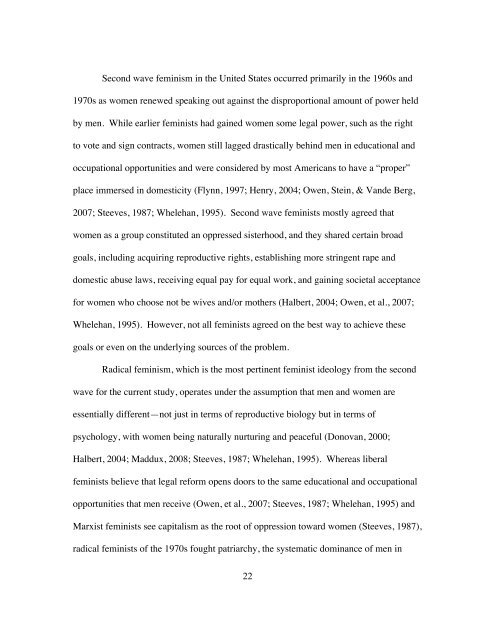Gender, Feminism, and Heroism in Joss Whedon and John ...
Gender, Feminism, and Heroism in Joss Whedon and John ...
Gender, Feminism, and Heroism in Joss Whedon and John ...
You also want an ePaper? Increase the reach of your titles
YUMPU automatically turns print PDFs into web optimized ePapers that Google loves.
Second wave fem<strong>in</strong>ism <strong>in</strong> the United States occurred primarily <strong>in</strong> the 1960s <strong>and</strong><br />
1970s as women renewed speak<strong>in</strong>g out aga<strong>in</strong>st the disproportional amount of power held<br />
by men. While earlier fem<strong>in</strong>ists had ga<strong>in</strong>ed women some legal power, such as the right<br />
to vote <strong>and</strong> sign contracts, women still lagged drastically beh<strong>in</strong>d men <strong>in</strong> educational <strong>and</strong><br />
occupational opportunities <strong>and</strong> were considered by most Americans to have a “proper”<br />
place immersed <strong>in</strong> domesticity (Flynn, 1997; Henry, 2004; Owen, Ste<strong>in</strong>, & V<strong>and</strong>e Berg,<br />
2007; Steeves, 1987; Whelehan, 1995). Second wave fem<strong>in</strong>ists mostly agreed that<br />
women as a group constituted an oppressed sisterhood, <strong>and</strong> they shared certa<strong>in</strong> broad<br />
goals, <strong>in</strong>clud<strong>in</strong>g acquir<strong>in</strong>g reproductive rights, establish<strong>in</strong>g more str<strong>in</strong>gent rape <strong>and</strong><br />
domestic abuse laws, receiv<strong>in</strong>g equal pay for equal work, <strong>and</strong> ga<strong>in</strong><strong>in</strong>g societal acceptance<br />
for women who choose not be wives <strong>and</strong>/or mothers (Halbert, 2004; Owen, et al., 2007;<br />
Whelehan, 1995). However, not all fem<strong>in</strong>ists agreed on the best way to achieve these<br />
goals or even on the underly<strong>in</strong>g sources of the problem.<br />
Radical fem<strong>in</strong>ism, which is the most pert<strong>in</strong>ent fem<strong>in</strong>ist ideology from the second<br />
wave for the current study, operates under the assumption that men <strong>and</strong> women are<br />
essentially different—not just <strong>in</strong> terms of reproductive biology but <strong>in</strong> terms of<br />
psychology, with women be<strong>in</strong>g naturally nurtur<strong>in</strong>g <strong>and</strong> peaceful (Donovan, 2000;<br />
Halbert, 2004; Maddux, 2008; Steeves, 1987; Whelehan, 1995). Whereas liberal<br />
fem<strong>in</strong>ists believe that legal reform opens doors to the same educational <strong>and</strong> occupational<br />
opportunities that men receive (Owen, et al., 2007; Steeves, 1987; Whelehan, 1995) <strong>and</strong><br />
Marxist fem<strong>in</strong>ists see capitalism as the root of oppression toward women (Steeves, 1987),<br />
radical fem<strong>in</strong>ists of the 1970s fought patriarchy, the systematic dom<strong>in</strong>ance of men <strong>in</strong><br />
22

















